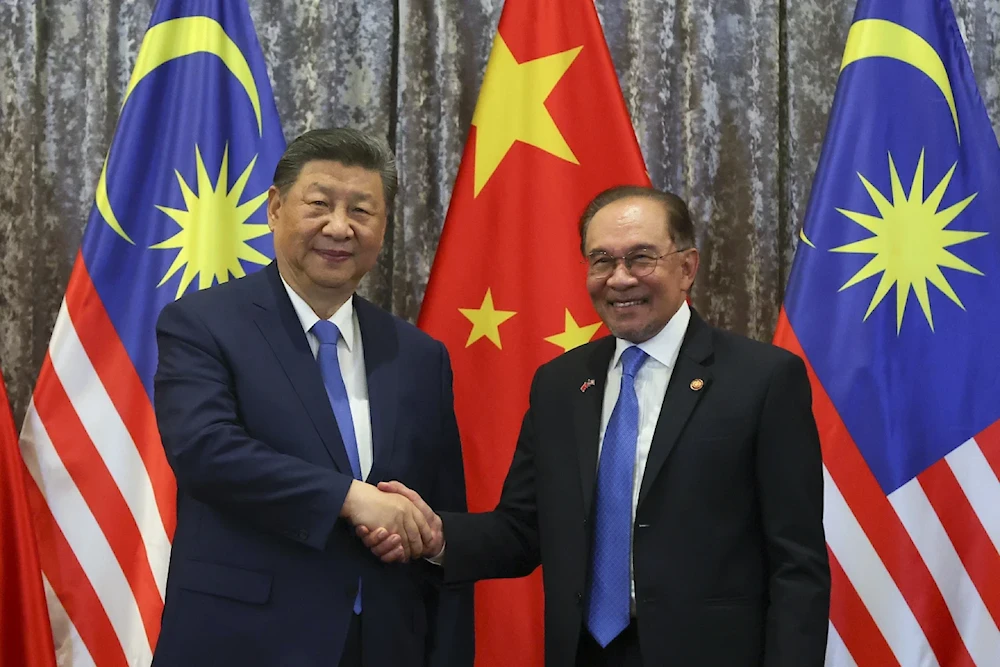China-Malaysia $22bln tech park deal boosts industrial cooperation
A landmark $22 billion tech park in Shenzhen aims to deepen China-Malaysia industrial cooperation, drive innovation, and accelerate regional economic growth.
-
 Chinese President Xi Jinping, left, shakes hands with Prime Minister of Malaysia, Anwar Ibrahim, April 16, 2025, Kuala Lumpur (AP)
Chinese President Xi Jinping, left, shakes hands with Prime Minister of Malaysia, Anwar Ibrahim, April 16, 2025, Kuala Lumpur (AP)
China and Malaysia have made a major leap in strengthening their industrial partnership through a $22 billion deal to co-develop the China-Malaysia High-Tech Eco-Industrial Park in Shenzhen, Guangdong province. This flagship initiative is designed to deepen industrial collaboration, promote innovation, and stimulate economic growth for both countries.
Signed on Friday, the agreement between Shenzhen’s industry outbound alliance and Malaysian partners marks a significant achievement under the “Two Countries, Twin Parks” framework, a strategic initiative intended to connect the two nations' innovation and production capabilities.
"We want to create a shared home for Chinese and Malaysian companies," said Feng Qiang, president of the procurement association. "Though global uncertainties remain, Shenzhen once grew from scratch. Now, with experience, resources and strong determination, we're committed to making this park a benchmark for China-Malaysia cooperation and a model for replication elsewhere."
President Xi Jinping had an audience with His Majesty Sultan Ibrahim, King of Malaysia.
— Mao Ning 毛宁 (@SpoxCHN_MaoNing) April 16, 2025
China and Malaysia are good neighbors, good friends, and good partners. They visit each other often and see each other as family.
He will work together with King Sultan Ibrahim to guide the… pic.twitter.com/VpNrZtAWc1
Liu Jinghua, deputy director of the economic affairs center at the International Department of the Central Committee of the Communist Party of China, voiced the same aspirations. "We hope the project will become a highland of innovation in China-Malaysia high-tech collaboration and pioneer a replicable model for cross-border corporate expansion," Liu said.
"By integrating Malaysia's market and resource advantages with China's strengths in research and development and manufacturing, the park can nurture a high-tech industrial cluster and drive innovation."
Three core pillars
The industrial park will be structured around three core pillars: vertical international collaboration, institutional innovation, and inclusive growth.
With the vertical collaboration model, research and development are centered in Shenzhen, while manufacturing is conducted in Malaysia. The initial phase will target key emerging industries such as AI, new energy technologies, and advanced equipment manufacturing. 28 companies from Shenzhen have already committed to joining the project.
Institutional innovation is a crucial component. Quality assurance standards from Shenzhen, such as ISO9001, will be extended to operations in Malaysia. Additionally, a cross-border digital customs platform will be implemented to streamline trade with "single declaration, dual clearance" procedures. To date, 42 service providers, including Huawei Cloud and SF International, have joined the project ecosystem.
Inclusive development will focus on empowering Malaysian small and medium-sized enterprises. A special fund will be created to help local businesses enhance their technological capabilities and integrate into high-tech value chains. One standout example is the partnership between Shenzhen’s Googol Technology and Malaysian semiconductor testing firm Censof. This collaboration, which combines technology investment with shared order fulfillment, is expected to create approximately 1,200 jobs in the region.
Shenzhen Economic Zone
The Shenzhen Special Economic Zone (SEZ) is a designated area in Guangdong Province, China, established on August 26, 1980, as the country's first SEZ. Initially comprising four districts, Luohu, Futian, Nanshan, and Yantian, the zone expanded in 2010 to encompass the entire city of Shenzhen. This expansion significantly increased its geographical size and economic influence. The SEZ was created as part of China's broader reform and opening-up policies, aiming to attract foreign investment, foster technological innovation, and serve as a model for economic modernization.
As part of the agreement, the Shenzhen government procurement association and the outbound alliance will take the lead in coordination efforts. They aim to tap into the advantages of the SEZ to attract key industry players, support business establishment, and develop a complete industrial and supply chain system.
As part of the agreement, the Shenzhen government procurement association and the outbound alliance will take the lead in coordination efforts. They aim to tap into the advantages of the SEZ to attract key industry players, support business establishment, and develop a complete industrial and supply chain system.
In a recent interview with Xinhua News Agency, Chinese Ambassador to Malaysia Ouyang Yujing emphasized Malaysia’s rising profile as an attractive destination for Chinese investment, especially in next-generation industries.
He pointed to recent expansions by Chinese electric vehicle manufacturers like Geely and Chery into Malaysia, which are strengthening regional supply chains. At the same time, data center initiatives from companies like GDS and Chindata Group are accelerating the country’s digital transformation.

 4 Min Read
4 Min Read









